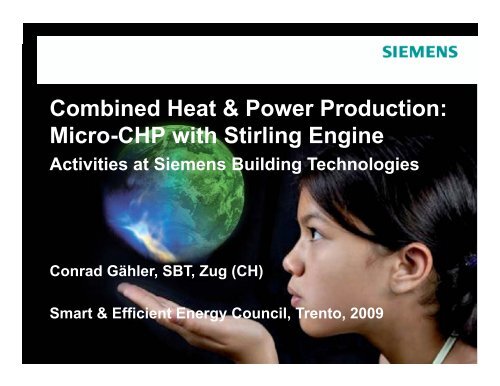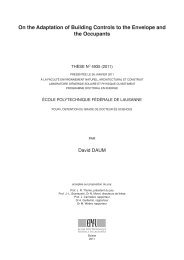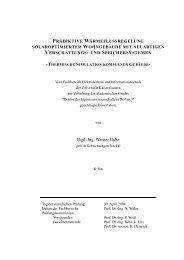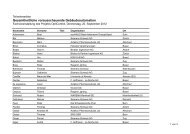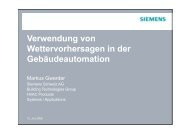Combined Heat & Power Production: Micro-CHP with Stirling Engine
Combined Heat & Power Production: Micro-CHP with Stirling Engine
Combined Heat & Power Production: Micro-CHP with Stirling Engine
You also want an ePaper? Increase the reach of your titles
YUMPU automatically turns print PDFs into web optimized ePapers that Google loves.
<strong>Combined</strong> <strong>Heat</strong> & <strong>Power</strong> <strong>Production</strong>:<br />
<strong>Micro</strong>-<strong>CHP</strong> <strong>with</strong> <strong>Stirling</strong> <strong>Engine</strong><br />
Activities at Siemens Building Technologies<br />
Conrad Gähler, SBT, Zug (CH)<br />
Smart & Efficient Energy Council, Trento, 2009
Siemens Building Technologies (SBT)<br />
Our key figures<br />
Fiscal year 2008<br />
Oct’07 – Sept’08<br />
SBT<br />
Total<br />
Siemens<br />
Revenue (mio. euros) 6.0 G€<br />
Employees 38,500 ca. 500,000<br />
Revenue<br />
Employees<br />
Europe<br />
CIS, Africa<br />
60%<br />
Americas<br />
33%<br />
Europe<br />
CIS, Africa<br />
54%<br />
54%<br />
36%<br />
Americas<br />
36%<br />
Asia, Australia<br />
Middle East<br />
7%<br />
Asia, Australia,<br />
Middle East<br />
10%<br />
Copyright © Siemens<br />
2 Oct 2009 C. Gähler: <strong>Micro</strong>-<strong>CHP</strong> <strong>with</strong> <strong>Stirling</strong> <strong>Engine</strong>. SEEC’09<br />
Siemens Building Technologies
Building Technologies<br />
Areas of activity<br />
Security<br />
Fire Safety<br />
Building<br />
Automation<br />
Energy Efficiency<br />
Electrical<br />
Installation<br />
Total Building<br />
Solutions<br />
Copyright © Siemens<br />
3 Oct 2009 C. Gähler: <strong>Micro</strong>-<strong>CHP</strong> <strong>with</strong> <strong>Stirling</strong> <strong>Engine</strong>. SEEC’09<br />
Siemens Building Technologies
BT Comfort at a glance…<br />
Energy Efficiency Components for the Smart Building<br />
Boilers<br />
Chillers<br />
Lighting<br />
BACS<br />
Wind<br />
Solar <strong>Heat</strong> Pump<br />
(3<br />
(4)<br />
<strong>Heat</strong> & <strong>Power</strong><br />
)<br />
Solutions<br />
Services<br />
Value<br />
Added<br />
Partners<br />
Resellers &<br />
Installers<br />
OEMs<br />
Regional companies<br />
Products & Systems<br />
HQ / production sites<br />
Just renamed from<br />
„HVAC Products to“<br />
„Control Products and Systems“<br />
Copyright © Siemens<br />
4 Oct 2009 C. Gähler: <strong>Micro</strong>-<strong>CHP</strong> <strong>with</strong> <strong>Stirling</strong> <strong>Engine</strong>. SEEC’09<br />
Siemens Building Technologies
Agenda<br />
1<br />
Introduction Siemens Building Technologies<br />
2<br />
Trends in building control (HVAC+)<br />
3<br />
Siemens <strong>Micro</strong>-<strong>CHP</strong> Control System (MCS)<br />
4<br />
<strong>Micro</strong>-<strong>CHP</strong>: Research<br />
5<br />
… Questions & Answers<br />
Copyright © Siemens<br />
5 Oct 2009 C. Gähler: <strong>Micro</strong>-<strong>CHP</strong> <strong>with</strong> <strong>Stirling</strong> <strong>Engine</strong>. SEEC’09<br />
Siemens Building Technologies
Trends (1)<br />
Alternative energy sources, Renewables<br />
Trend to fragmentation & renewable in<br />
residential buildings<br />
Key trends & findings<br />
High<br />
Efficiency<br />
Wall Hung<br />
Boiler<br />
Wall Hung<br />
Boiler<br />
Floor<br />
Standing<br />
Boiler<br />
<strong>Heat</strong> Pump<br />
& Biogas<br />
<strong>Micro</strong> Co<br />
<strong>Heat</strong><br />
Directives for energy-<br />
& emission reduction<br />
less heating<br />
needed<br />
Shift from oil & gas<br />
towards renewable<br />
energies<br />
Demand based<br />
heating, cooling and<br />
ventilation<br />
80th and 90th 2008 ≥2020<br />
Copyright © Siemens<br />
6 Oct 2009 C. Gähler: <strong>Micro</strong>-<strong>CHP</strong> <strong>with</strong> <strong>Stirling</strong> <strong>Engine</strong>. SEEC’09<br />
Siemens Building Technologies
Trends (2)<br />
Integrating more than HVAC<br />
Automating the Room…<br />
Shaping the future!<br />
Energy Management & Monitoring<br />
Smart Grid & Smart Metering<br />
Energy Storage<br />
Intelligent facades<br />
Air Quality<br />
µC<br />
IT & Communication<br />
<strong>Heat</strong><br />
Pumps<br />
<strong>Micro</strong><br />
<strong>CHP</strong><br />
Thermal<br />
Solar<br />
Photovoltaic<br />
Mastering the Core…<br />
Managing alternative Energies…<br />
Copyright © Siemens<br />
7 Oct 2009 C. Gähler: <strong>Micro</strong>-<strong>CHP</strong> <strong>with</strong> <strong>Stirling</strong> <strong>Engine</strong>. SEEC’09<br />
Siemens Building Technologies
Trends (3)<br />
Energy efficiency<br />
• Laws, regulations,<br />
committments of communities and companies<br />
public opinion / image<br />
• Desigo Building Management System:<br />
Monitoring, TABS Low exergy, …<br />
Additional functionality in next release<br />
• Better quantification of energetic benefit of control functions<br />
convince planners, owners, operators, and users<br />
to ask for the best available technology<br />
need for approved results for standard cases;<br />
simulation tools that can cope <strong>with</strong> innovative technology;<br />
norms ...<br />
• Mentioned in all printed matters<br />
Copyright © Siemens<br />
8 Oct 2009 C. Gähler: <strong>Micro</strong>-<strong>CHP</strong> <strong>with</strong> <strong>Stirling</strong> <strong>Engine</strong>. SEEC’09<br />
Siemens Building Technologies
Agenda<br />
1<br />
Introduction Siemens Building Technologies<br />
2<br />
Trends in building control (HVAC+)<br />
3<br />
Siemens <strong>Micro</strong>-<strong>CHP</strong> Control System (MCS)<br />
4<br />
<strong>Micro</strong>-<strong>CHP</strong>: Research<br />
5<br />
… Questions & Answers<br />
Copyright © Siemens<br />
9 Oct 2009 C. Gähler: <strong>Micro</strong>-<strong>CHP</strong> <strong>with</strong> <strong>Stirling</strong> <strong>Engine</strong>. SEEC’09<br />
Siemens Building Technologies
<strong>Micro</strong>-<strong>CHP</strong>:<br />
The power plant in the own house<br />
Copyright © Siemens<br />
10 Oct 2009 C. Gähler: <strong>Micro</strong>-<strong>CHP</strong> <strong>with</strong> <strong>Stirling</strong> <strong>Engine</strong>. SEEC’09<br />
Siemens Building Technologies
<strong>Micro</strong>-<strong>CHP</strong><br />
Energy flow, principle<br />
Author<br />
Losses<br />
<strong>Heat</strong><br />
exchanger<br />
<strong>Heat</strong><br />
Fuel (gas)<br />
<strong>CHP</strong><br />
appliance<br />
Generator<br />
Electric energy<br />
Oct 2009<br />
11 C. Gähler: <strong>Micro</strong>-<strong>CHP</strong> <strong>with</strong> <strong>Stirling</strong> <strong>Engine</strong>. SEEC’09<br />
Copyright © Siemens Schweiz AG 2006<br />
Building Technologies / HVAC Products
<strong>Micro</strong>-<strong>CHP</strong><br />
Comparison of energy flows<br />
Conventional house<br />
House <strong>with</strong> m-<strong>CHP</strong> unit<br />
Author<br />
Oct 2009<br />
12 C. Gähler: <strong>Micro</strong>-<strong>CHP</strong> <strong>with</strong> <strong>Stirling</strong> <strong>Engine</strong>. SEEC’09<br />
Copyright © Siemens Schweiz AG 2006<br />
Building Technologies / HVAC Products
<strong>Stirling</strong> engine:<br />
Operating principle and key advantages<br />
Key advantages of SE:<br />
• External combustion<br />
„clean“ exhaust gases<br />
• Frequent start/stopps ok<br />
(comparing to fuel cell)<br />
• Linear arrangement:<br />
• Running at 50Hz<br />
no inverter needed<br />
• No moving seals<br />
maintenance-free<br />
for whole lifetime<br />
The EU considers domestic heat generation <strong>with</strong><br />
<strong>Stirling</strong>-based <strong>CHP</strong> as one of the most promising<br />
technologies to save CO2 in a mid timeline<br />
support (Taxes, feed-in tariffs) can be expected<br />
Oct 2009<br />
13 C. Gähler: <strong>Micro</strong>-<strong>CHP</strong> <strong>with</strong> <strong>Stirling</strong> <strong>Engine</strong>. SEEC’09<br />
Copyright © Siemens Schweiz AG 2006<br />
Building Technologies / HVAC Products<br />
Author
<strong>Micro</strong> <strong>CHP</strong>:<br />
<strong>Stirling</strong> <strong>Engine</strong> & Generator<br />
Generator<br />
<strong>Stirling</strong> engine<br />
Cooling<br />
water<br />
Burner<br />
flame<br />
Author<br />
Oct 2009<br />
14 C. Gähler: <strong>Micro</strong>-<strong>CHP</strong> <strong>with</strong> <strong>Stirling</strong> <strong>Engine</strong>. SEEC’09<br />
Copyright © Siemens Schweiz AG 2006<br />
Building Technologies / HVAC Products
<strong>Micro</strong> <strong>CHP</strong> product development:<br />
Partners<br />
<strong>Micro</strong>gen <strong>Stirling</strong> <strong>Engine</strong><br />
Consortium MEC:<br />
European boiler manufacturers:<br />
Remeha, Baxi, and others<br />
Pel: 1 kW<br />
Pth: 6 kW + 10 .. 30 kW<br />
Large field tests 2009<br />
Market introduction 2010<br />
USPs of Siemens solution<br />
• Complete solution: Automatic firing device (gas valve, ignition ...),<br />
control (heat production, consumers), grid supervision<br />
• Homogeneous product range for m<strong>CHP</strong>, conv. Boilers,<br />
heat pumps, solar, wood, …<br />
Copyright © Siemens<br />
15 Oct 2009 C. Gähler: <strong>Micro</strong>-<strong>CHP</strong> <strong>with</strong> <strong>Stirling</strong> <strong>Engine</strong>. SEEC’09<br />
Siemens Building Technologies
Generator running at 50Hz<br />
→ no inverter needed<br />
micro <strong>CHP</strong><br />
System Architecture<br />
DHW: Storage or „Combi“<br />
Up to 3<br />
heating<br />
circuits,<br />
more <strong>with</strong><br />
additional<br />
controllers<br />
Additional part<br />
for m-<strong>CHP</strong><br />
Standard BMU<br />
Optional:<br />
Buffer storage<br />
Author<br />
Oct 2009<br />
16 C. Gähler: <strong>Micro</strong>-<strong>CHP</strong> <strong>with</strong> <strong>Stirling</strong> <strong>Engine</strong>. SEEC’09<br />
Copyright © Siemens Schweiz AG 2006<br />
Building Technologies / HVAC Products
micro <strong>CHP</strong><br />
Grid supervision<br />
• The electric grid must be supervised<br />
Generator must be disconnected from the grid very quickly in case of<br />
• Over-/undervoltage<br />
• Over-/underfrequency<br />
• Missing grid ( Islanded operation currently not supported)<br />
• Hardware by Siemens A&D<br />
• Norms are country specific:<br />
• GB, NL, … G83/1 single measurement<br />
• D, A, CH, F<br />
VDE 0126-1-1 redundant measurement<br />
Author<br />
Oct 2009<br />
17 C. Gähler: <strong>Micro</strong>-<strong>CHP</strong> <strong>with</strong> <strong>Stirling</strong> <strong>Engine</strong>. SEEC’09<br />
Copyright © Siemens Schweiz AG 2006<br />
Building Technologies / HVAC Products
MCS:<br />
Controller tasks & challenges<br />
SuppBu<br />
EngBu<br />
Supply<br />
air<br />
flow<br />
TBoiler<br />
THead<br />
To be optimised<br />
• Minimize SuppBu operation<br />
• Maximize EngBu operation<br />
Without too many starts/stopps!<br />
See next topic (Model Predictive Control)!<br />
<strong>Stirling</strong> <strong>Engine</strong> (6kWth, 1kWel), Supp Burner (10..30kW)<br />
2 Gas valves, ignition; Grid connection and supervision; boiler pump, DHW div. valve<br />
Modulate burner power via supply air mass flow<br />
To be controlled: THead (500°C), TBoiler (according to heat demand, e.g. 55°C)<br />
Copyright © Siemens<br />
18 Oct 2009 C. Gähler: <strong>Micro</strong>-<strong>CHP</strong> <strong>with</strong> <strong>Stirling</strong> <strong>Engine</strong>. SEEC’09<br />
Siemens Building Technologies
MCS: Model-based design <strong>with</strong> Simulink<br />
Controller<br />
(<strong>Heat</strong> production)<br />
Plant model:<br />
<strong>Stirling</strong> + SuppBu + Hydraulics<br />
(+ consumers)<br />
Quant + dead times<br />
measurements<br />
Scope<br />
Copyright © Siemens<br />
19 Oct 2009 C. Gähler: <strong>Micro</strong>-<strong>CHP</strong> <strong>with</strong> <strong>Stirling</strong> <strong>Engine</strong>. SEEC’09<br />
Siemens Building Technologies
MCS: Simulation results<br />
6: Supp Burner ein<br />
8: Supp Burner off<br />
12: ca. 30 Pulses per hour, is ok<br />
1: <strong>Engine</strong> on<br />
2: Generator<br />
connected<br />
10a: Supp Burner ein<br />
3: THead controlled<br />
very nicely!<br />
4: Fan drives<br />
EngBu back<br />
9: Due to overshoot of TBoiler, THeadSp is reduced.<br />
Is this reasonable? Point to discuss!<br />
11: Modulation of supp Bu is<br />
enabled after nach 10 Min<br />
5: TBoiler remains<br />
below setp<br />
7: TBoiler overshoots due to<br />
min heat output of SuppBu<br />
10: Step of TBoiler setp 60°C<br />
Copyright © Siemens<br />
20 Oct 2009 C. Gähler: <strong>Micro</strong>-<strong>CHP</strong> <strong>with</strong> <strong>Stirling</strong> <strong>Engine</strong>. SEEC’09<br />
Siemens Building Technologies
Comparison of workflows<br />
Functional<br />
specification<br />
(requirements)<br />
Functional<br />
specification<br />
(requirements)<br />
SW-Spec HVAC<br />
Manual Coding<br />
Simulink-Model<br />
=verified SW-Spec:<br />
Proof of control quality etc.<br />
„Classical“<br />
Implementation<br />
Device test<br />
(=Test Regelgerät)<br />
Module test<br />
Model-based design (Simulink)<br />
Code-<br />
Generation<br />
Module test<br />
Integration in appliance,<br />
at customer (England)<br />
Integration <strong>with</strong> engine,<br />
at customers (England)<br />
Device test<br />
Control problems become<br />
apparent only here<br />
Hardware-in-the-loop<br />
test<br />
Classical: Difficult<br />
to see what to change<br />
in case of problems<br />
Controller design <strong>with</strong> Simu:<br />
In case of problers <strong>with</strong> real HW:<br />
Good understanding<br />
targetted improvements<br />
possible<br />
Worked at once<br />
<strong>with</strong>out changing<br />
one single parameter change!<br />
With Code generation:<br />
Changes can be made<br />
very quickly & reliably<br />
in test phase!<br />
Copyright © Siemens<br />
21 Oct 2009 C. Gähler: <strong>Micro</strong>-<strong>CHP</strong> <strong>with</strong> <strong>Stirling</strong> <strong>Engine</strong>. SEEC’09<br />
Siemens Building Technologies
Agenda<br />
1<br />
Introduction Siemens Building Technologies<br />
2<br />
Trends in building control (HVAC+)<br />
3<br />
Siemens <strong>Micro</strong>-<strong>CHP</strong> Control System (MCS)<br />
4<br />
<strong>Micro</strong>-<strong>CHP</strong>: Research<br />
5<br />
… Questions & Answers<br />
Copyright © Siemens<br />
22 Oct 2009 C. Gähler: <strong>Micro</strong>-<strong>CHP</strong> <strong>with</strong> <strong>Stirling</strong> <strong>Engine</strong>. SEEC’09<br />
Siemens Building Technologies
Optimal control of m<strong>CHP</strong> building energy system<br />
<strong>with</strong> model predictive control (MPC)<br />
Control signals<br />
Loads and climate<br />
Copyright © Siemens<br />
23 Oct 2009 C. Gähler: <strong>Micro</strong>-<strong>CHP</strong> <strong>with</strong> <strong>Stirling</strong> <strong>Engine</strong>. SEEC’09<br />
Siemens Building Technologies
Optimization method:<br />
Performance bound <strong>with</strong> Model Predictive Control<br />
1. The control must satisfy the requirements for room &DHW<br />
temperature<br />
• PE-optimal control<br />
• Cost-optimal control<br />
2. We assume perfect a-priori knowledge of<br />
• System dynamics<br />
• Future wheather, hot-water draws etc.<br />
3. We compute the best theoretically possible operation strategy <strong>with</strong><br />
• Model predictive control (MPC)<br />
• Linear programming (LP)<br />
4. This result is called performance bound<br />
Copyright © Siemens<br />
24 Oct 2009 C. Gähler: <strong>Micro</strong>-<strong>CHP</strong> <strong>with</strong> <strong>Stirling</strong> <strong>Engine</strong>. SEEC’09<br />
Siemens Building Technologies
Focus / Questions<br />
Control strategy:<br />
What do cost- and PE-optimal operations look like?<br />
Performance assessment:<br />
Possible cost and PE savings?<br />
Impact of different parameters on optimal control and performance<br />
• Sizing of <strong>Stirling</strong> engine<br />
• Etc.<br />
Copyright © Siemens<br />
25 Oct 2009 C. Gähler: <strong>Micro</strong>-<strong>CHP</strong> <strong>with</strong> <strong>Stirling</strong> <strong>Engine</strong>. SEEC’09<br />
Siemens Building Technologies
Optimization constraints;<br />
Loads, climate, and tariffs<br />
Room temperature Hot water demand<br />
Electricity demand<br />
Climate, Gas & electricity tariffs:<br />
Zurich (Switzerland)<br />
Copyright © Siemens<br />
26 Oct 2009 C. Gähler: <strong>Micro</strong>-<strong>CHP</strong> <strong>with</strong> <strong>Stirling</strong> <strong>Engine</strong>. SEEC’09<br />
Siemens Building Technologies
Building types<br />
Three types of buildings (Old, WSV95, EnEV2000):<br />
4 apartments, 3 occupants each<br />
Floor space = 150 m2<br />
Sizing of SE and SB adapted to building insulation quality<br />
Nominal values<br />
Old<br />
(poor)<br />
WSV95<br />
(medium)<br />
EnEV2000<br />
(good)<br />
Building heat losses [W/K] 446 194 88<br />
Building time constant [h] 94 162 396<br />
<strong>Stirling</strong> Eng. heat output (η th =70%) [kW] 19.9 9.4 5<br />
<strong>Stirling</strong> Eng. Electr. <strong>Power</strong> (η el =25%) [kW] 7.1 3.4 1.8<br />
Supp burner heat output (η th =95%) [kW] 41 18 8.2<br />
Copyright © Siemens<br />
27 Oct 2009 C. Gähler: <strong>Micro</strong>-<strong>CHP</strong> <strong>with</strong> <strong>Stirling</strong> <strong>Engine</strong>. SEEC’09<br />
Siemens Building Technologies
Simulation results:<br />
Diurnal progression (base case)<br />
Building type: Old<br />
PE optimization<br />
Night setback<br />
DHW tank charged<br />
in the evening<br />
<strong>Engine</strong> runs through<br />
All night<br />
Supp burner is used for<br />
Morning boost<br />
Hot-water draws<br />
Copyright © Siemens<br />
28 Oct 2009 C. Gähler: <strong>Micro</strong>-<strong>CHP</strong> <strong>with</strong> <strong>Stirling</strong> <strong>Engine</strong>. SEEC’09<br />
Siemens Building Technologies
Efficiencies<br />
<strong>Stirling</strong> engine: ηel,ref = 25% (as Solo <strong>Stirling</strong> engine. <strong>Micro</strong>gen has less)<br />
Reference plant: η el,ref = 50%<br />
Marginal approach, modern CC gas plant <strong>with</strong> η el,ref = 56%<br />
10% grid losses always attributed to ref plant<br />
(import, export, in-house consumption)<br />
Copyright © Siemens<br />
29 Oct 2009 C. Gähler: <strong>Micro</strong>-<strong>CHP</strong> <strong>with</strong> <strong>Stirling</strong> <strong>Engine</strong>. SEEC’09<br />
Siemens Building Technologies
Primary energy optimization:<br />
Energy flow diagram<br />
Optimization criterion:<br />
Numbers: MWh, from<br />
whole-year simulation WSV95<br />
Performance assessment:<br />
Savings: 131 – 111 = 20<br />
Rel. Savings:<br />
20 / 87 = 22.9%<br />
Copyright © Siemens<br />
30 Oct 2009 C. Gähler: <strong>Micro</strong>-<strong>CHP</strong> <strong>with</strong> <strong>Stirling</strong> <strong>Engine</strong>. SEEC’09<br />
Siemens Building Technologies
Performance assessment:<br />
Whole-year simulation results<br />
Equivalent foll-load hours: ca. 270d/year<br />
Copyright © Siemens<br />
31 Oct 2009 C. Gähler: <strong>Micro</strong>-<strong>CHP</strong> <strong>with</strong> <strong>Stirling</strong> <strong>Engine</strong>. SEEC’09<br />
Siemens Building Technologies
Simulation results:<br />
Variation of the sizing of the <strong>Stirling</strong> <strong>Engine</strong><br />
Important<br />
savings<br />
Moderate<br />
savings<br />
No SE,<br />
stronger SB<br />
Base case<br />
Stronger SE,<br />
smaller SB<br />
More powerful SE ⇒ less expensive, less PE consumption<br />
⇒ but higher investment costs<br />
Optimal sizing can be determined by including investment costs<br />
Copyright © Siemens<br />
32 Oct 2009 C. Gähler: <strong>Micro</strong>-<strong>CHP</strong> <strong>with</strong> <strong>Stirling</strong> <strong>Engine</strong>. SEEC’09<br />
Siemens Building Technologies
Research<br />
Conclusions<br />
Method allows to determine possible savings<br />
<strong>CHP</strong> saves 20%-30% money and 20%-25% PE<br />
(<strong>with</strong> assumptions used, e.g. 56% el. Ref. plant,<br />
in optimal control operation)<br />
Results give hints and benchmark for simpler control strategies<br />
Influence of different parameters on optimal control<br />
• Sizing of <strong>Stirling</strong> engine, supplementary burner<br />
Attractive prices for feed-in electricity help to exploit potential<br />
Copyright © Siemens<br />
33 Oct 2009 C. Gähler: <strong>Micro</strong>-<strong>CHP</strong> <strong>with</strong> <strong>Stirling</strong> <strong>Engine</strong>. SEEC’09<br />
Siemens Building Technologies


